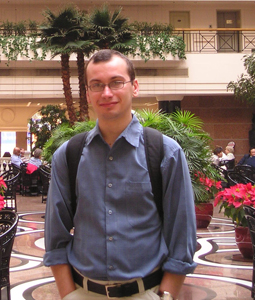Alexandru Balan ’03 and mentor make breakthrough in body-imaging technology
By Samuel T. Clover ’91
 A man in a hoodie and baggy jeans robs a liquor store. He points a shotgun at the clerk. An overhead security camera records the scene, but because of the man’s loose-fitting clothes, cops can’t tell much about him. He flees into the night, never to be seen again.
A man in a hoodie and baggy jeans robs a liquor store. He points a shotgun at the clerk. An overhead security camera records the scene, but because of the man’s loose-fitting clothes, cops can’t tell much about him. He flees into the night, never to be seen again.
Or maybe so, thanks to computer vision technology created by Alexandru Balan ’03, a graduate student at Brown University, and his professor, Michael Black. The two have created a program that uses complex algorithms and a database of scanned body images to estimate gender, height, weight, and even the chest and waist sizes of clothed, moving figures in videos.
Balan was inspired by tackling criminal cases with police departments in Rhode Island and Virginia.
“Working on real forensic problems for my research was really motivating,” he says. “Over the last few years, I had the opportunity to analyze together with other students several surveillance video sequences related to unsolved crimes that have provided additional leads to the investigations.”
His efforts even garnered him a commendation by the chief of police of Henrico County, Va.
A double major in computer science and math at Lafayette, Balan honed his interdisciplinary research skills as an EXCEL Scholar while investigating abstract concepts such as set theory, symbolic logic, and Boolean algebra. Though he appreciated the “theoretical questions” that came up in the classroom, he decided to pursue more real-world applications in graduate school, specifically robotics.
“At Lafayette I had gained the necessary skill set to attack large projects that have significant experimental parts to them by studying simplified, abstract versions of problems involving graph and geometric algorithms, as well as game theory,” Balan says. “Once accepted at Brown University, I discovered the field of computer vision, an integral part of robotics that gives robots the ability to see, and I’ve embraced it ever since.”
Balan and Black’s program is a marked improvement over current body-imaging technology, which requires people to stand still — sans clothing — to create an accurate 3-D human model. Using a stockpile of body images originally scanned by a company to design uniforms for the Air Force, the researchers created their database of models by manipulating the original scans with avatars, or little handles, that made the figures skinny or fat, short or tall. They could also animate the images with a skeleton-like core.
“The main idea for estimating body shape under clothing is to learn how the human shape varies from person to person, or during movement,” Balan explains. “We were able to do that using as examples about 2,400 laser scans of various people wearing just bathing suits.”
“The fact that the subject moves is important,” he continues, “because various poses provide additional constraints on the true shape under the clothes: They become tighter or looser along different parts of the body during movement.”
The crime-fighting technology has a variety of potential uses outside the law-enforcement field. Couture aficionados could virtually “try on” outfits online without stepping foot in a store. Sports doctors could use computerized models of athletes’ bodies to predict potential injuries. Video gamers could insert accurate images of themselves onscreen — or maybe a slimmer, sexier version of their bodies created at home with avatars, instead of going to the gym. If only real life were so easy.
 A man in a hoodie and baggy jeans robs a liquor store. He points a shotgun at the clerk. An overhead security camera records the scene, but because of the man’s loose-fitting clothes, cops can’t tell much about him. He flees into the night, never to be seen again.
A man in a hoodie and baggy jeans robs a liquor store. He points a shotgun at the clerk. An overhead security camera records the scene, but because of the man’s loose-fitting clothes, cops can’t tell much about him. He flees into the night, never to be seen again.